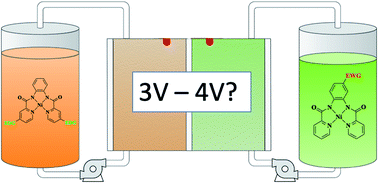Expanding the potential of redox carriers for flow battery applications†
Abstract
Using theoretical modeling to guide our approach, substituents were selected to improve the negative and positive potentials associated with a representative metal-based redox carrier, a phenyl spaced nickel bispicolinamide complex, [Ni(bpb)], 1. To broaden the cell potential, electron donating groups were selected and installed on the pyridyl moieties, [Ni(bpb-(NMe2)2)], 2, while electron withdrawing groups were incorporated on the phenyl linker, [Ni(bpb-R)] (R = –F, –CF3, and –NO2), 3–5. Our model predicts an increase of ∼300 mV and ∼500 mV for the first and second negative waves of Ni(bpb-NMe2), 2, and up to ∼330 mV and ∼210 mV increase to the first and second positive waves in 3–5. The modeled complexes were synthesized in good yields using a modification of the literature procedure. Due to limited solubility, the differential pulse voltammetry was measured on complexes 2–5 using a drop cast technique. Comparison of the observed and predicted potentials is discussed in acetonitrile (MeCN) and dimethylformamide (DMF) solvents.



 Please wait while we load your content...
Please wait while we load your content...